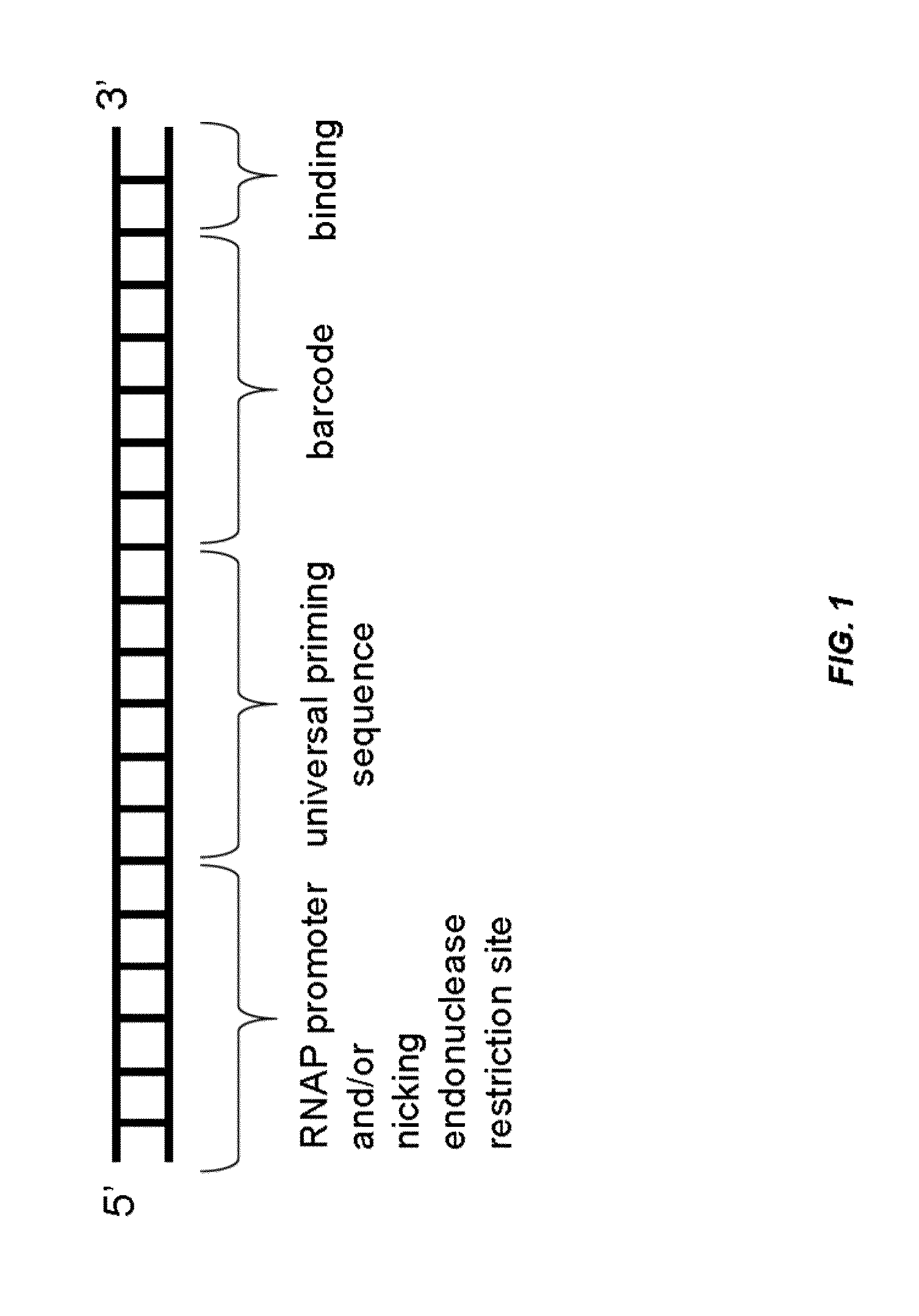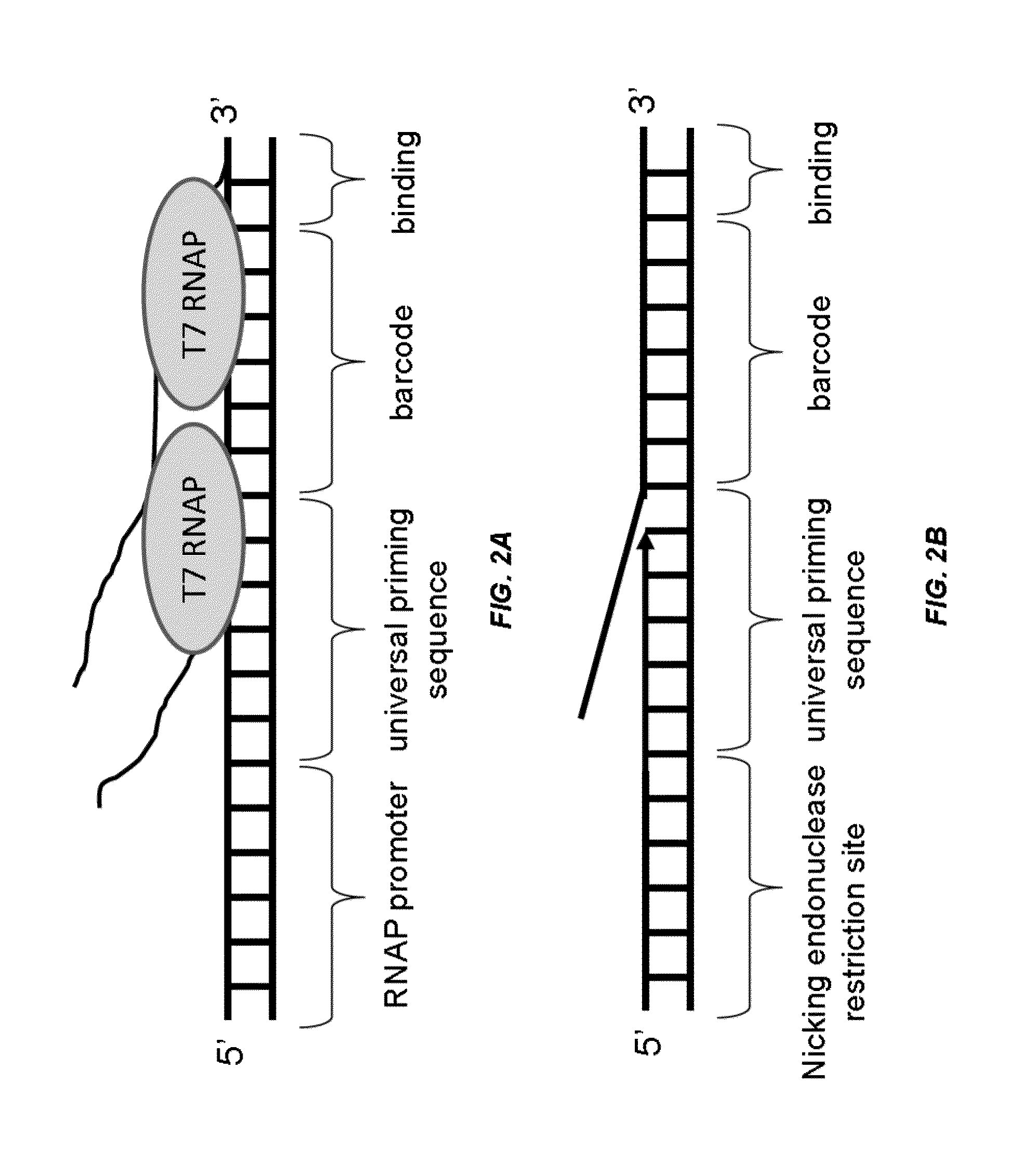Analysis of nucleic acids associated with single cells using nucleic acid barcodes
a nucleic acid barcode and nucleic acid technology, applied in specific use bioreactors/fermenters, laboratory glassware, biomass after-treatment, etc., can solve the problem of slow and laborious, difficult to distinguish pcr and sequencing errors from true biological variation, and large variety of possible sequences
- Summary
- Abstract
- Description
- Claims
- Application Information
AI Technical Summary
Benefits of technology
Problems solved by technology
Method used
Image
Examples
example 1
A. Example 1
Making Barcode Adapter Template Bead Library in a Single Reaction
[0278]The method described below was used to create a barcode adapter template bead library using emulsion PCR, where polymerase chain reaction (PCR) was performed to attach unique barcode adapter templates to each bead (see FIG. 15).
TABLE 4Oligos used to make barcode adapter template bead library in a single reactionPrimer nameSequence (SEQ ID NO:)emB-T7bridge2dual-biotin-C18spacer-C18spacer-TAA TAC GAC TCA CTA TAG GATAAA GCG GCC GCA AAT (1)emB-BCbridge2mCmCC CCT GTT TAA ACC THH HTH HHH THH HHT HHH THHHHA TTT GCG GCC GCT TTA T (2) (random combination of HHHTH HHH THH HHT HHH THH HH (3), has 318 or 387 × 106 possibilities,giving 387 million unique barcodes)emB-T7bridgefreeTAA TAC GAC TCA CTA TAG GAT AAA GCG GCC GCA AAT (4)emB-Rv3AlexaFluor647-C18spacer-mCmCC CCT GTT TAA ACC T (5)
[0279]Streptavidin-coated M-270 Dynabeads® (Life Technologies) were coupled with biotinylated oligonucleotide (“emB_T7bridge2”):[0...
example 2
B. Example 2
Making Barcode Adapter Template Bead Library in a Single Reaction II
[0324]The method described below was used to create a barcode adapter template bead library using emulsion PCR, where polymerase chain reaction (PCR) was performed to attach unique barcode adapter templates to each bead (see FIG. 15).
TABLE 5Oligos used to make barcode adapter template bead library in a single reaction IIPrimer nameSequence (SEQ ID NO:)emB-T7bridgeIsceIdual-biotin-C18spacer-C18spacer-TAA TAC GAC TCA CTA TAG GATAGG GAT AAC AGG GTA ATA GGA (7)emB_BCbridgeISceI_2mCmCC CCA GTT TAA ACT CCTH HHT HHH HTH HHH THH HTHHHH TCC TAT TAC CCT GTT ATC CC (8)(random combination of HH HTH HHH THH HHT HHH THH HH (3), has318 or 387 × 106 possibilities, giving 387 million unique barcodes)emB-TAA TAC GAC TCA CTA TAG GAT AG GGATAACAGGGTAATAGGAT7bridgefreeIsceI_2(9)emB_IsceI_RVAlexaFluor647-C18spacer-mCmCC CCA GTT TAA ACT CCT (10)
[0325]Streptavidin-coated M-270 Dynabeads® (Life Technologies) were coupled with bi...
example 3
C. Example 3
Making Barcode Adapter Template Bead Library in Multi-Steps
[0368]In this example reactions as per FIG. 16 were done, except that only one S1, one W, and one S2 barcode sequence used. Therefore, pooling of beads coupled to different S1 sequences did not occur, and similarly, beads were not pooled after the polymerase extension reaction to add W sequences to the S1 oligo.
[0369]This example can be easily extended to be done as per FIG. 16 simply by having multiple S1-oligo, W-oligo and S2-oligo with unique barcode sequences.
TABLE 6Oligos used to make barcode adapter template bead library in a single reactionPrimer nameSequence (SEQ ID NO:)S1-oligoDesthiobiotin-C18spacer-ATA TTA ATA CGA CTC ACT ATA GGC ATA GGGATA ACA GGG TAA TGA [S1] AG (11), where S1 = GATGGATW-oligo-aCCT CCT CCT CCT CCC [W] CTI III III TCA TTA CCC TGT TATCCC TAT GCC (12), where W = AGTGAGCTGCGTW-oligo-bCT CCT CCT CCC [W] CTI III III TCA TTA CCC TGT TAT CCCTAT GCC (13), where W = AGTGAGCTGCGTS2-oligo-amCmCC...
PUM
| Property | Measurement | Unit |
|---|---|---|
| diameter | aaaaa | aaaaa |
| pH | aaaaa | aaaaa |
| pH | aaaaa | aaaaa |
Abstract
Description
Claims
Application Information
 Login to View More
Login to View More - R&D
- Intellectual Property
- Life Sciences
- Materials
- Tech Scout
- Unparalleled Data Quality
- Higher Quality Content
- 60% Fewer Hallucinations
Browse by: Latest US Patents, China's latest patents, Technical Efficacy Thesaurus, Application Domain, Technology Topic, Popular Technical Reports.
© 2025 PatSnap. All rights reserved.Legal|Privacy policy|Modern Slavery Act Transparency Statement|Sitemap|About US| Contact US: help@patsnap.com



